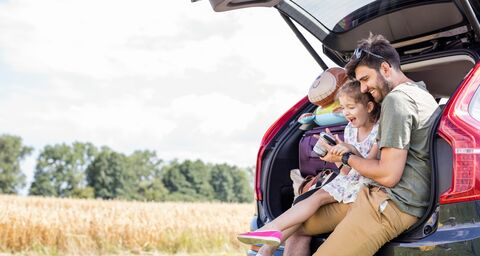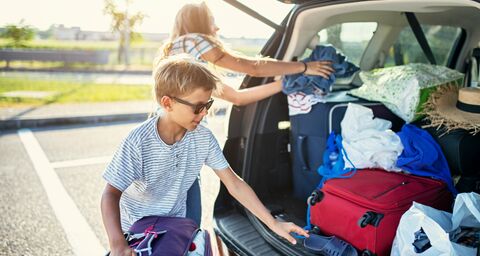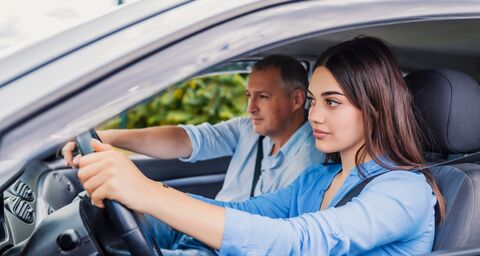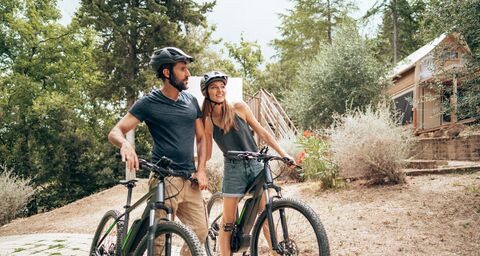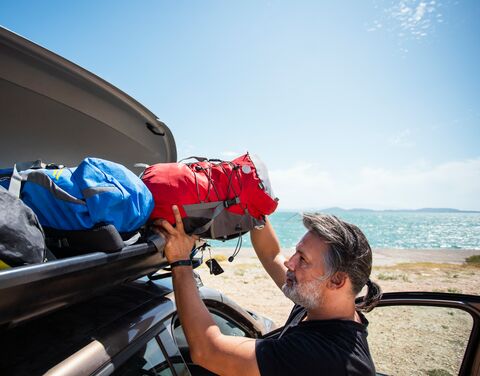
How to load a roof box
If everything you need for your trip won't fit in the trunk, a roof rack can help. A roof box or rear-mounted box offers even more load space. These add-on cargo carriers keep your baggage safe and free up room inside the car for a more comfortable journey, but what do you have to bear in mind when you use them?
Luca Genovese, head of Research and Prevention and head of AXA Mobility Competence Center, explains how to load up your car's roof safely.
When is it worth buying a roof box?
Luca Genovese: When you're going on vacation, your bags, suitcases, and sports equipment take up a lot of space. If you have small children, you probably have large items like a stroller or a cot as well. If you don't want to sacrifice comfort, it's time to get a roof box.
What do I have to bear in mind when choosing which size of roof box to buy?
The roof box shouldn't extend past the rear end of the car and prevent you from opening the trunk. Ideally, it shouldn't stick out at the front either because that's bad for the car's aerodynamics. If you want to use your roof box in the winter, you should make sure it's long enough to hold your skis.
"Lighter items are loaded at the front and back of the roof box, heavier ones in the middle."
How do I load a roof box correctly to avoid endangering myself and other road users?
First of all, make sure that your roof bars are fitted correctly. That's usually the biggest challenge.
Here are some simple rules for loading your roof box:
- Place lighter items at the front and back.
- Use a blanket to pad out the front and prevent items from breaking through the box if you have to do an emergency stop.
- Heavier items should go in the middle.
- Use straps to stop items moving around.
What doesn't belong in the roof box?
Really heavy items like a stroller shouldn't go in the roof box. It's better to put them in the trunk, which should have more space thanks to the roof box.
Is there a maximum roof load for cars in Switzerland?
That's a very important point! It varies, but a roof load of around 50 kg is normally allowed. Your vehicle registration document shows the exact figure. Don't forget that the roof load includes the weight of the box itself (10-20 kg) and the roof bars (5-6 kg). In many cases, that means you're only allowed about 25-35 kg of baggage.
What if I don't need the roof box very often?
| You should take the roof box off when you're not using it. Even if it's empty, it significantly increases your car's fuel consumption. |
With that in mind, look for a box that's easy to remove and fit back on the roof when you need it. That way, you enjoy flexibility without wasting fuel.
What are the dangers of the extra height, for example in parking garages and tunnels and on bridges?
Tunnels and bridges are generally high enough, but it depends on the type of vehicle. It's important to remember that the roof bars as well as the box add to the overall height.
You must always pay attention to the maximum height indicated at the entrance to a parking garage. It can vary a lot, and a maximum height of less than two meters isn't uncommon.
I recommend measuring your car with the roof bars and box fitted, writing the height down on a piece of paper, and placing it somewhere you can easily see while driving as a reminder.
What happens in heavy wind and rain? Will the box stay attached in bad weather?
Yes, it will – provided the roof bars and box have been fitted properly. That said, a roof box does mean that side winds will affect your car more. If a sudden gust catches you unawares, it can be dangerous, especially on the highway.
The roof box also raises your car's center of gravity, which alters the way it handles. You need to drive more carefully, particularly in a van, minibus or SUV. The vehicle will behave differently in corners, and the increased weight will make the braking distance longer.
How waterproof is my roof box in heavy rain?
Rain and humidity can be a problem if you're carrying items that are sensitive to water. These shouldn't be placed at the front of the box because this is where moisture is more likely to get in while you're driving. For extra peace of mind, you can pack them in waterproof plastic bags first.
Some roof boxes have small openings at the back so that the air flowing around the box can suck out any water that gets inside. Take care not to cover these up.
Do I need to make lots of rest stops to check my roof box?
There's no need to make extra rest stops just because of the box, but you should take a break at least every two hours on any journey, box or no box. If you take items out when you stop, you should run through another safety check to make sure your load is correctly positioned, any straps are tightened up, and the box is closed properly before you get back on the road.
How can I protect my roof box against theft?
Some roof boxes have locks. If you're staying at a campsite, you shouldn't take the box off your car and leave it unattended. We do keep hearing reports of stolen roof boxes and bike racks.
Do you have any tips regarding rear-mounted racks?
If your car has a towbar, you can choose a rack that attaches to it. These can usually take more weight, and they tend to work with a variety of bikes, including electric ones. Make sure the rack is genuinely strong enough to take the weight of your e-bike without any sign of strain.
As a rule, tailgate-mounted racks are cheaper and lighter. It's essential to follow the instructions for fitting them carefully so they stay in place if you have to brake or swerve sharply.
How high may the total weight be when loading a car?
Whether you are moving house or going on vacation: Your car is not allowed to exceed the permissible total weight limit. If you need to transport a lot of luggage or heavy items, you should know how heavy the load is. In the event of a check, you risk the following consequences:
Loading a roof box – examples
| Example | Criminal consequence |
| Exceeding the permissible total weight by up to 100 kg | CHF 100 fine |
| Exceeding the permissible total weight by more than 100 kg, but by less than 5% of the vehicle’s total weight | CHF 200 fine |
| Exceeding the permissible total weight by more than 100 kg and 5% of the vehicle’s total weight | Penal order, which leads to proceeding costs as well as fines and/or financial penalties. You also risk losing your license. |

